|
Today is the ninth day of the Lunar New Year and the festive atmosphere still pervades everywhere. Apart from visiting your relatives and friends, there is a place I would like to recommend you to go. Presented by the Leisure and Cultural Services Department and organised by the Antiquities and Monuments Office (AMO), the “Reminiscences: Life in Hong Kong’s Built Heritage” exhibition is being held at the Hong Kong Heritage Discovery Centre in Kowloon Park in Tsim Sha Tsui. Members of the public are welcome to visit the exhibition and know more about the historic buildings in Hong Kong and the city’s experiences in built heritage conservation. With the thriving development of the Hong Kong economy in the 1970s, skyscrapers have become the distinctive urban landscape of the city. Nonetheless, a number of nostalgic historic buildings have been well preserved amid rapid modernisation. Historic buildings are carriers of history and culture, which contain myriad messages and reflect our social development. They are also the collective memories of the community and witnesses to our history.
Through the light-hearted stories of two imaginary figures who were born respectively in the urban area of Hong Kong and a walled village in the New Territories in the 1920s, the exhibition showcases historic buildings related to various aspects of their lives, including their births, homes, beliefs, education, medical care, entertainment and marriage. It vividly illustrates the architectural styles of old Hong Kong and shares with visitors the history, culture and arts of the buildings. Rare building components, documents, artefacts and photographs of historic buildings are also on display at the venue. Highlight exhibits include the first-generation Bishop’s Throne of St John’s Cathedral in Central; the wooden signboard of the Chun Yuen Pawn House in Yuen Long Old Market, the oldest surviving pawn shop in Hong Kong; the door lock and key of Victoria Prison in Central; the cast iron halberd formerly used in martial arts training by the TANGs at Cheung Chun Yuen in Kam Tin; the collection of wood-carved oracles at Hung Shing Temple in Kau Sai Chau, Sai Kung; and the apparel and accessories of the deity statues at Man Mo Temple in Sheung Wan under the management of the Tung Wah Group of Hospitals. It will certainly be a good idea to stop by and appreciate them.
Apart from the precious relics, the exhibition also displays images and models created by using advanced 3D stereoscopic scanning and printing technology. It presents to visitors a wide array of historic buildings in Hong Kong and our cutting-edge restoration techniques. Visitors will feel just like moving around the real historic buildings and entering the mysterious places never or rarely open to the public. In addition, the AMO has invited the Legend Bricks, an amateur group of building block-lovers, to create models of historic buildings with toy bricks to demonstrate their architectural features in a light-hearted and creative manner. To further enhance public understanding of historic buildings, the AMO will host a series of seminars on historic buildings in April, and will co-organise with the University of Hong Kong a symposium on traditional Chinese architectural measurement system. You all are welcome to attend and share your ideas with us.
Sustainable development of heritage conservation
The Development Bureau (DEVB) attaches great importance to heritage conservation. So far, there are a total of 114 declared monuments under the protection of the Antiquities and Monuments Ordinance. The Antiquities Advisory Board has also completed the grading exercise for more than 1 300 historic buildings, which provides an objective basis to assess their heritage value and conservation needs. Besides, through the Revitalising Historic Buildings Through Partnership Scheme, the Commissioner for Heritage’s Office of the DEVB has invited non-profit-making organisations to revitalise 19 government-owned historic buildings. Eight have completed revitalisation works, and among them, four won the Asia-Pacific Awards for Cultural Heritage Conservation of the United Nations Educational, Scientific and Cultural Organisation. Apart from the revitalisation of government-owned historic buildings, the participation of private owners is equally important in promoting the conservation of built heritage. For example, the F11 Photographic Museum, 11 Yuk Sau Street, Happy Valley, was converted from a Grade 3 historic building and reflects the public’s aspirations for built heritage conservation.
This year marks the 20th anniversary of the establishment of the Hong Kong Special Administrative Region. Looking back on the transformation of Hong Kong from a small fishing village to an international metropolis today, generations of Hong Kong people have witnessed the passage of time and the changes of our architecture. As part of the anniversary celebrations, the “Reminiscences: Life in Hong Kong’s Built Heritage” exhibition will hopefully give the visiting public a deeper insight into the former important roles of Hong Kong’s historic buildings and a glimpse of the social landscape in the past. Besides, visitors will better understand our conservation efforts in revitalising historic buildings for adaptive re-uses in the modern society and the fruits of our hard work in heritage conservation.
I would like to wish you all the best and our heritage conservation work a great success in the coming year!
Other information:
Date: 20 January to 1 May 2017
Venue: Hong Kong Heritage Discovery Centre
Opening Hours: Mondays to Wednesdays, Fridays: 10a.m. – 6p.m.
Saturdays, Sundays and public holidays: 10a.m. – 7p.m.
Free Admission
|
|
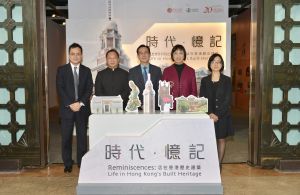 |
|
(From left) José YAM Ho-san, Commissioner for Heritage of the Development Bureau; Andrew LAM Siu-lo, Chairman of the Antiquities Advisory Board; Eric MA Siu-cheung, Acting Secretary for Development; Michelle LI Mei-sheung, Director of Leisure and Cultural Services; and Susanna SIU Lai-kuen, Executive Secretary of the Antiquities and Monuments Office, officiate at the opening ceremony of the “Reminiscences: Life in Hong Kong’s Built Heritage” exhibition earlier on.
|
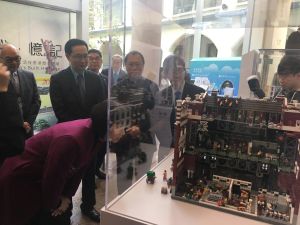 |
|
The exhibition showcases models of historic buildings made with toy bricks, vividly illustrating the buildings’ features.
|
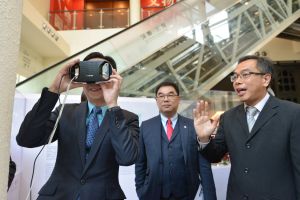 |
|
Eric MA (left), Acting Secretary for Development, tries out a virtual reality device.
|
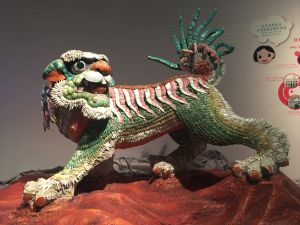 |
|
Picture shows the trencadís lion which used to be an ornament at the Tiger Balm Garden. Built in 1935, the Garden was a “theme park” for free admission in the early days of Hong Kong.
|
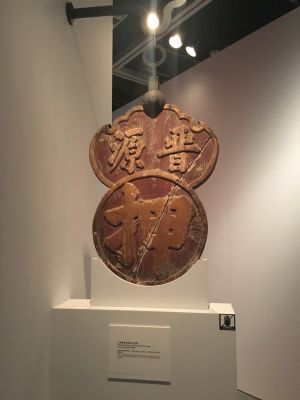 |
|
Picture shows the wooden signboard of the Chun Yuen Pawn House (built in the 1910s) in Yuen Long Old Market, which is the oldest surviving pawn shop signboard in Hong Kong.
|
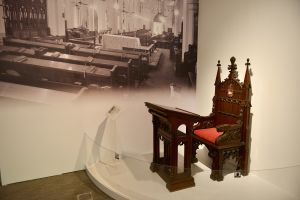 |
|
Picture shows the Bishop’s Throne of St John’s Cathedral in Central constructed in 1849. This is the first-generation Bishop’s Throne of the Cathedral and can be dated back to about 1898.
|
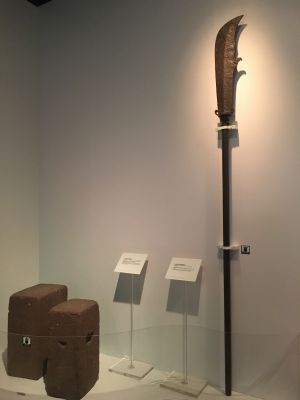 |
|
Picture shows the cast iron halberd formerly used in martial arts training at Cheung Chun Yuen in Kam Tin. Established in the mid-19th century, Cheung Chun Yuen was one of the few schools dedicated to training military students in Hong Kong.
|
|